The City of Edmonton is accepting vendors Expressions of Interest for recreational rental services at William Hawrelak Park. Apply by Dec 31, 2025.
For all inquiries, please review this documentation or contact Taha.Rizvi@edmonton.ca, Senior Buyer.
Main page content begins here
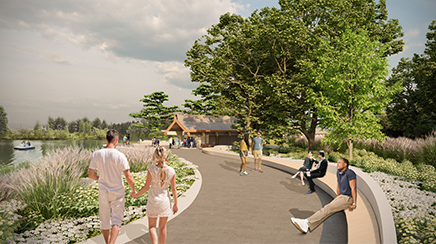
Hawrelak Park is temporarily closed for rehabilitation of utilities, facilities, open spaces, paths and roads.
The City of Edmonton is accepting vendors Expressions of Interest for recreational rental services at William Hawrelak Park. Apply by Dec 31, 2025.
For all inquiries, please review this documentation or contact Taha.Rizvi@edmonton.ca, Senior Buyer.
Events at William Hawrelak Park have been temporarily relocated while the park is rehabilitated.
The William Hawrelak Park Rehabilitation Project is approaching the end of construction. The project continues on time and on budget.
Throughout 2025, substantial progress has been made on landscaping and park facilities, including the picnic shelters, Main Pavilion and the operations yard.
The following project work has recently been completed:
The remaining rehabilitation work includes:
Construction is anticipated to be completed in the coming months. As construction activity slows down, the City will prepare the space (installing picnic tables, benches, signage, etc.) and staff to safely reopen the park to the public. The park is anticipated to reopen in winter 2025/2026.
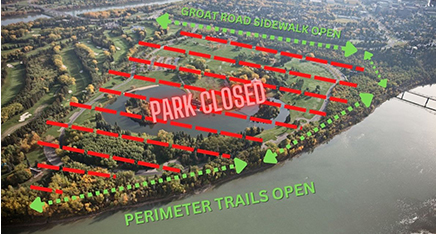
Access to trails, parking and washrooms within the park is not available. The river valley trail system around the perimeter of the park remains open for users to safely enjoy the river valley trail system. The trails around the Royal Mayfair Golf Club are not affected by the construction.
The new and improved Groat Road Stairs reopened in March 2024. Occasionally, short-term detours of trails may still be necessary during replacement of infrastructure with connections to the river. During those times, detours will be posted.
Public washrooms within the park are closed for rehabilitation as part of this project. Public washroom facilities in Emily Murphy Park, Buena Vista Park and Sir Wilfrid Laurier Park provide nearby access for trail users.
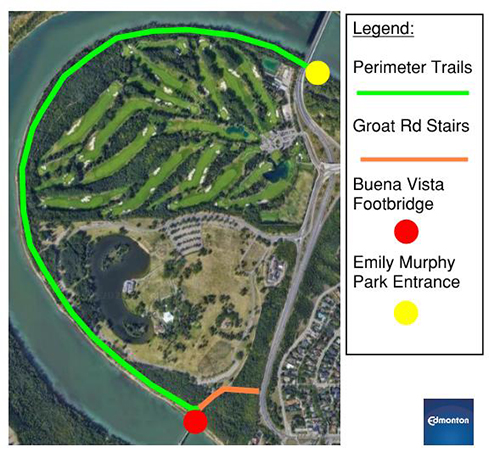
A map showing the access points to the perimeter trails around William Hawrelak Park.
Perimeter trails are accessible around the park, although there is no access for parking within William Hawrelak Park during construction. Trail access parking is available at the adjacent park sites, including: Buena Vista Park, Sir Wilfrid Laurier Park, Emily Murphy Park and Victoria Park.
The William Hawrelak Park Rehabilitation Project was identified as a priority to address aging park infrastructure and meet future demands.
The project addresses the utility, transportation, open spaces and facility infrastructure throughout the park. Most of the infrastructure is original to the park since its opening in 1967. The infrastructure has exceeded its lifespan and requires repair, replacement or upgrading to remain operational and meet current and future demands.
To learn more about the project, please watch the project overview video. Please note: the park playground mentioned in the video will be replaced with a new playground.
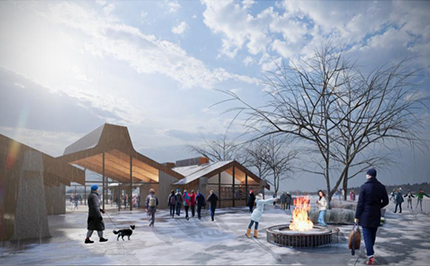
Artist rendering of the Main Pavilion with direct outdoor access for skate rentals.
Construction is occurring throughout the park. While utility replacement comprises the majority of the project, park facilities and open spaces are also included in the overall rehabilitation.
The following items are included in the rehabilitation project:
Extensive interested party and public engagement was conducted for this project. Residents and the main users groups of the park, including festival and event groups, were engaged in the planning and design of this project, as well as on the construction approach (implementation plan).
During the engagement process, user groups and residents shared feedback and perspectives on how the current park infrastructure could better support programs, services, safety, security, access and circulation. This input was combined with park infrastructure condition assessments, operational requirements and technical standards and policies to identify project priorities and guide the development of the implementation plan.
Engagement took place with First Nations and Métis communities to mitigate the impact of construction through an on-site monitoring program. This has also been supported by an archaeologist and paleontologist.
The project team (including external architects, engineers, construction managers and advisors) reviewed multiple implementation options involving a full closure or phased closures. They decided on a full closure as it provided the shortest construction timeline and was the best option for safety. This decision was difficult and the project team recognizes the effect that the park closure has on the community.
The William Hawrelak Park Main Pavilion, Boat House and Picnic Shelters #1, #2 and #3 were built between 1968 and 1973. These structures are examples of mid-20th-century modern architecture with clean lines, organic forms and clear influences of West Coast post-and-beam construction.
All 5 structures share a distinct architectural form with parallel concrete column-and-beam systems supporting timber rafter trusses. The roof design has tongue-and-groove cedar decking topped with cedar shakes. The roofline of each structure leads along a curve to a series of central domed skylights. This shared form is important to the heritage value of the structures.
In 2023, City Council designated the Main Pavilion, Boat House and Picnic Shelters #1, #2 and #3 as Municipal Historic Resources under the Alberta Historical Resources Act. As a result, the rehabilitation project is restoring or preserving the existing concrete columns, roof trusses and original wood features accordingly. For example, the extensive wood features in the Main Pavilion are being restored to their original natural cedar colour.
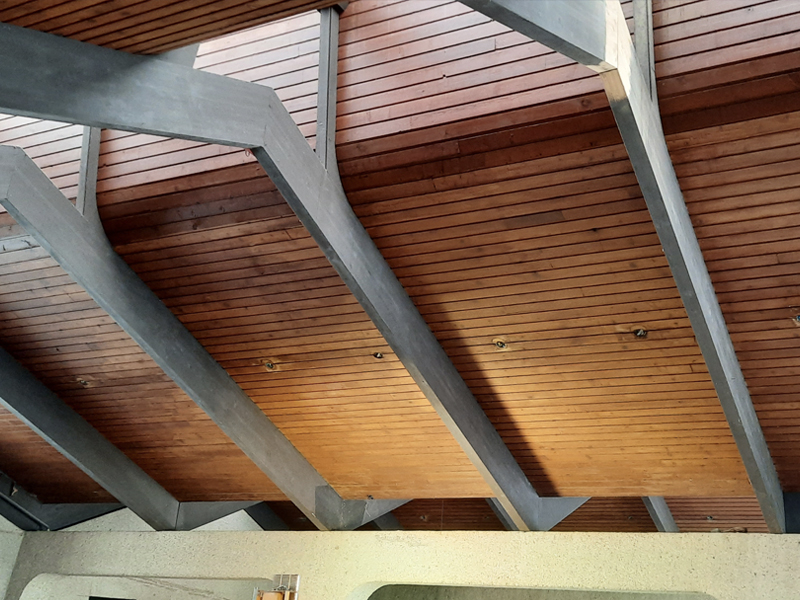
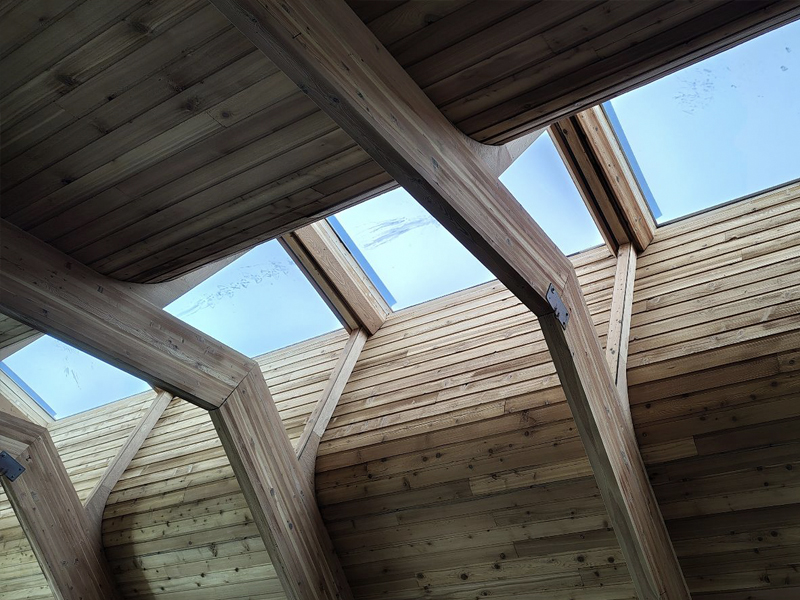
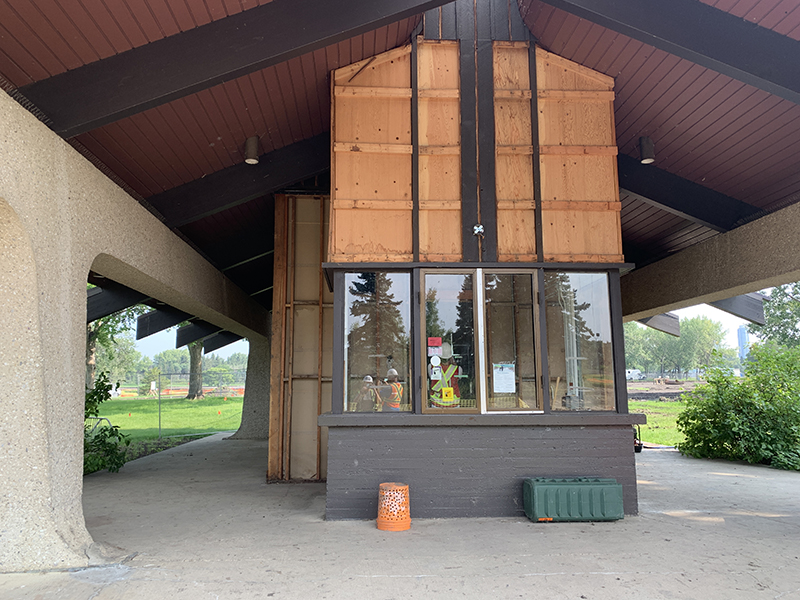
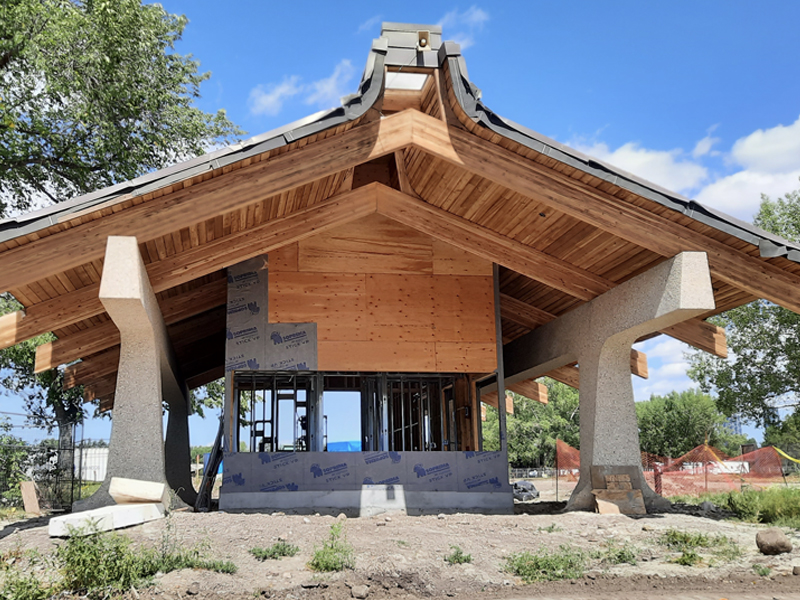
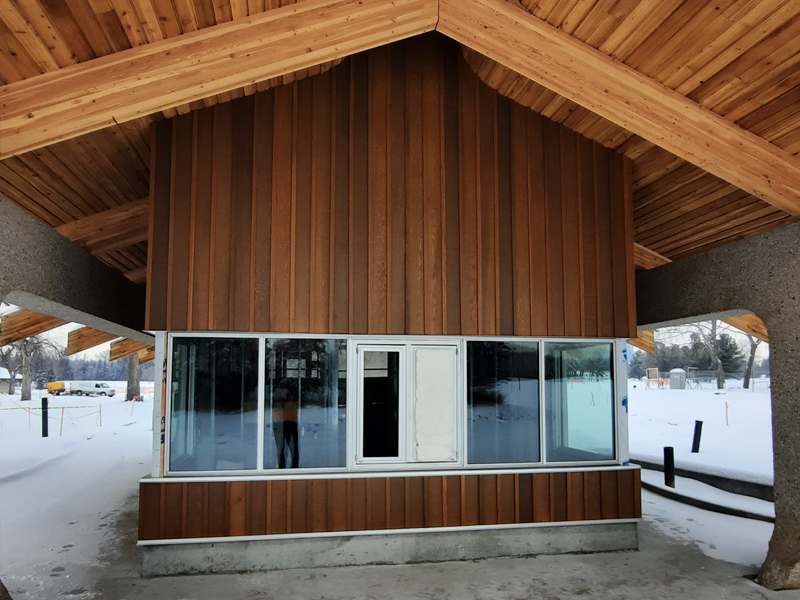
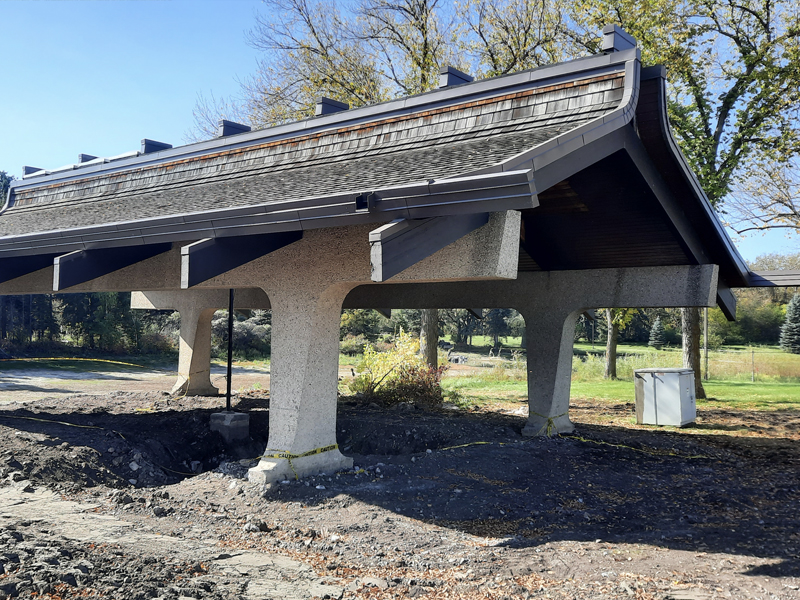
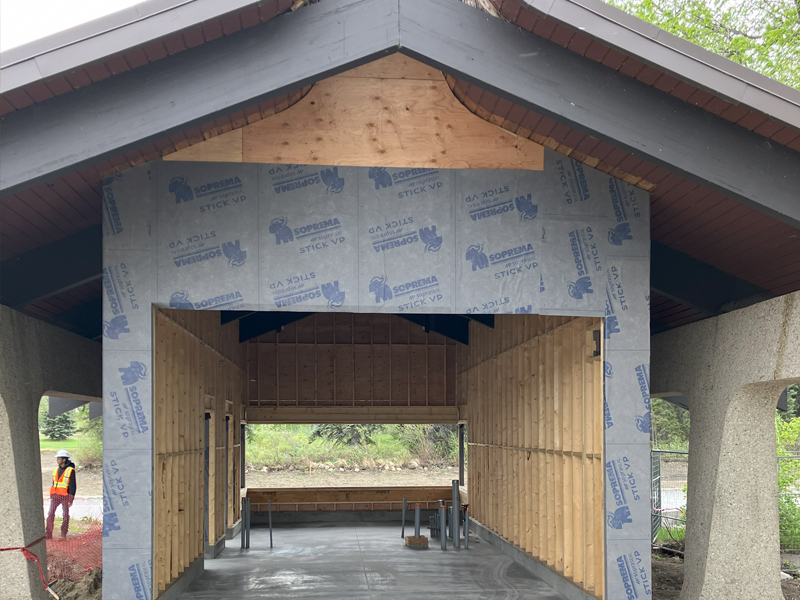
The William Hawrelak Park Rehabilitation Project is within the regulatory framework of the North Saskatchewan River Valley Area Redevelopment Plan (ARP). This is Bylaw 7188, also known as the River Valley Bylaw or River Valley ARP, which provides the standards and rules that guide evaluation of individual projects and developments in the River Valley.
An Environmental Impact Assessment, or EIA, is a process to identify, predict and evaluate the potential environmental effects of a project and ensure environmental stewardship throughout the duration of a project. EIAs are done early in the design process to meet the requirements of the River Valley ARP, which requires City Council approval prior to committing funds for the capital expenditure of the construction work.
The EIA for this project was approved by City Council in May 2022. As a result of the EIA being early in the process, the EIA included conditions that must be met and approved by City Administration as the project progresses. These conditions included the completion of a Tree Preservation Plan, a Tree Restoration Plan and Tree Removal Inventory.
The Tree Preservation Plan includes critical details about site conditions, work activities and recommendations and actions that will take place on site prior to and during work activities to preserve City trees. This plan must be signed by a person with an approved professional designation including, but not limited to, ISA Certified Arborist, Consulting Arborist, Landscape Architect or a professional designation in a related field in forestry, horticulture or agriculture.
The Tree Restoration Plan includes a planting plan for direct revegetation of the site and specifies plant types and locations.
A Council Report on the Tree Management for the William Hawrelak Park Rehabilitation Project (IIS01731) was prepared for the Urban Planning Committee on May 2, 2023, and approved by the Urban Planning Committee on June 2, 2023. Included in this report were the Tree Preservation Plan (90 MB) and the Tree Restoration Plan.
This rehabilitation project requires the removal of some trees as part of work related to utilities, improvements for accessibility and safety, and ensuring long-term stewardship of the park and facilities. The project team regularly meets to review each area as it relates to tree preservation and impacts on the park. Working with our construction partners, we continue to find ways to make adjustments in construction methods in order to preserve as many potentially impacted trees as possible.
The project includes planting new open space trees and restoring the natural areas equal to that which is disturbed in the long-term. The final year of the project allows for landscaping to be established prior to full park operations.
This project is complex and involves many interrelated scopes of work, including deep underground utilities, shallow utilities, park facilities, open spaces, transportation and the environment. The work will be done throughout all areas of the park. Full closure of the park for several years allows work on utilities, facilities and open spaces to run concurrently at times while providing the necessary staging area and overall site safety.
The deep underground utility infrastructure, including the storm, sanitary, water distribution, power and irrigation systems, is all being replaced. This creates safety concerns if any portions of the park are left open and also must be done prior to any surface work. This adds complexity throughout the project scope and a full closure provides the greatest opportunity to overlap timelines. Given the scope of the project, three years is required.
The project team, in consultation with a range of experts, explored all construction methods and options and conducted extensive engagement to determine the best course of action. Phased approaches as well as full closure were assessed to determine the best strategy.
This is a complex project due to the significant interdependencies with utilities. A phased approach would have required installation of temporary utility services to keep the park operating. Otherwise, some services would be unavailable until work was complete. Neither option would be appealing to the public or festival teams.
The phased approach with partial park closures would extend the construction schedule to 10 years. Even with the phased approach, the impacts from the scopes of work would continue during that entire time and affect large areas of the park, especially related to the underground utility work. There was not a phased scenario that could be implemented in a manner that would allow for continued operation in a safe manner or for park festivals to operate at an acceptable level.
The deep underground utility infrastructure work is one of the primary drivers in examining the approach. The work is extensive throughout the park and requires a significant amount of space and heavy equipment to undertake the trench and backfill activities. For example, a typical 3 to 4 metres deep pipe installation can require up to 16 to 20 metres width in working space when taking into account both the trench dimensions with safe cutback slopes as well as the space for a spoil pile to stage the excavated material.
Full park closure will result in the shortest construction timeline (up to 3 years). It is the most efficient (cost and schedule) approach with a focus on minimizing impacts to users.
We differentiate between trees in open spaces and those within natural areas. Open space trees are individually counted and natural areas are determined by total area.
The most recent park tree inventory indicated a total of:
Estimates are as of April 2023, representing a point in time and evolving as field work progresses. For natural areas, the amount of area to be disturbed is 1,512 square metres - limited to relatively narrow slivers on select edges of natural stands and seven smaller locations. (Source: Urbfor Tree Preservation Plan, page 15).
For open space trees (Source: Urbfor Tree Preservation Plan, page 19), of the 2,483 open space trees in the park, 741 trees are located within the Tree Protection Zones. These trees are located within 5 metres of work being conducted or within 5 metres of the boulevards. Of those 741 trees within the Tree Protection Zones, 544 trees will be protected (saved). These have fencing or other protective measures as outlined in the Tree Preservation Plan. Of the remaining open space trees, we estimate 112 may need to be removed due to deep utility work. We emphasize “may” as some removals may be mitigated. Those decisions cannot be made until the work is ongoing, so this 112 could be lower once work progresses.
In addition, 85 trees have been identified as being impacted by grading and City protection requirements. As field work progresses, we will better understand the outcome of these trees. All efforts are being made to protect as many of these trees as possible. This is a worst-case estimate as we anticipate identifying measures to save many of these trees. A final tree removal inventory will be prepared by the contracted arborist in collaboration with City Urban Forestry once all tree removals are field verified.
Prior to construction starting, in addition to addressing Environmental Impact Assessment conditions and using the Tree Preservation Plan, the Project is required to get a City Public Tree Permit.
The project is then responsible to follow all protection and preservation guidelines that are outlined through the Public Tree Permit. This includes protection fences, anti-compaction mitigation and other construction techniques. The intent of the Tree Preservation Plan and Public Tree Permit is to identify potential damages and implement mitigation techniques to avoid these damages.
Each tree is required to have a 5 metre protection zone around it. These zones are identified for each tree that is near construction. If construction impedes that zone, then it undergoes a review by the project team. This works to eliminate any trees getting unnecessarily damaged from construction.
However, in the event that a tree not slated for removal gets damaged, a City Forester will assess the damage and identify whether it would necessitate removal or remediation of the impacted tree. The corporate tree management policy will be applied to collect equitable compensation for full or partial tree loss.
Yes. New open space trees will be planted and restoration of natural areas equal to that which is disturbed will be conducted. The Tree Restoration Plan provides details on the plantings.
The City of Edmonton values every single tree, and removals are guided by the City’s Corporate Tree Policy and Public Tree Bylaw 18825 which prioritize the preservation and protection of trees and ensures equitable compensation for canopy loss. In addition to other design disciplines, the project team includes ecological planners, City Urban Forestry and Natural Area Operations, external arborists and other environmental subject matter experts within, and external to, City Administration.
These groups provide guidance and support to ensure adherence to the approved Environmental Impact Assessment, Tree Management Plan, legislative requirements, policies, and bylaws. Beyond project planning and design, these teams are on site during construction to take inventory of what trees require protection, removal, and replacement. Replacement trees will be planted within the final year of the rehabilitation project, allowing for plantings to establish.
The river valley trail system around the perimeter of the park will remain open for users to safely enjoy the river valley trail system. Occasionally, short-term detours of trails may be necessary. The trails remaining open will allow users to safely bypass around the park. All trails inside the park will be closed due to the construction.
City rehabilitation projects, like this project, often involve electrical, structural and mechanical updates which improve energy efficiencies and reduce consumption. While these updates are driven by the lifecycle of the infrastructure, the benefits to energy efficiency and environmental sustainability cannot be ignored. The City looks at all aspects of rehabilitation projects to address items which can improve climate resiliency — from switching to LED lighting to improving insulation.
The William Hawrelak Park Rehabilitation Project illustrates how environmental sustainability measures are a core component of rehabilitation and can have a profound impact. As part of the planning and design process, work was completed to identify steps needed to align with the City’s Sustainable Building Policy. Examples of steps taken include:
Parking is being removed in some areas along the perimeter road. To offset these changes, the main parking area is being extended. This will add more spaces to the main parking area near the entrance of the park and overall the park will see a minor increase in the number of stalls.
No, the washrooms in William Hawrelak Park are closed. The utilities for these facilities are disconnected for ongoing work. Temporary washrooms on the trail were considered and are not feasible due to inaccessibility for necessary service and maintenance. Nearby public washroom facilities are available in Emily Murphy Park, Buena Vista Park and Sir Wilfrid Laurier Park. See list of public washrooms.
The City of Edmonton boasts some of the most beautiful and scenic picnic areas in all of Alberta. Located in the heart of the City's parks, our picnic sites are available for reservation (for a guaranteed spot) or on a first-come, first-served basis. For details, visit the picnic sites page.
As the largest urban park in Canada, with more than 160 kilometres of maintained pathways and 20 major parks, the River Valley is a natural wonder for all Edmontonians to be proud of. For a list of other parks in the river valley, visit the river valley parks page.
The North Saskatchewan River is a natural connection between neighbouring municipalities. The City maintains numerous docks and launches throughout Edmonton. This provides public access, allows travel along the river and supports the regional park concept. For more details, visit the boating and canoeing page.
The William Hawrelak Park Rehabilitation Project is approaching the end of construction. The project continues on time and on budget.
Throughout 2025, substantial progress has been made on landscaping and park facilities, including the picnic shelters, Main Pavilion and the operations yard.
The following project work has recently been completed:
The remaining rehabilitation work includes:
Construction is anticipated to be completed in the coming months. As construction activity slows down, the City will prepare the space (installing picnic tables, benches, signage, etc.) and staff to safely reopen the park to the public. The park is anticipated to reopen in winter 2025/2026.
Rehabilitation work continues across William Hawrelak Park. Paving of the roadways and shared pathway continues. Electrical work continues around the park, including additional pathway lighting for security.
Facility work on the Main Pavilion, Heritage Amphitheatre, picnic shelters and main service yard continues. Work on the mechanical and electrical systems, interior framing and finishing in all facilities is underway. The refinishing of the interior wood ceilings and structures in all facilities is complete. The concrete work inside and outside all facilities is complete. The concrete for the lakefront path and seating is complete.
Landscaping will continue throughout 2025. The grading of Hawrelak Lake and work on the vegetative buffer around the lake are complete. The landscaping will need time to establish before the park can reopen to the public.
Rehabilitation work continues across William Hawrelak Park. Paving of the roadways and shared pathway continues. Facility work continues on the Main Pavilion, Heritage Amphitheatre, main service yard and picnic shelters. Landscaping work has started and will continue throughout 2025. The rehabilitation of the two overflow drainage outfalls at the North Saskatchewan River is complete.
Watch the William Hawrelak Park Year Two video to learn more.
Rehabilitation work continues across William Hawrelak Park. Paving of the park roadways and shared pathway continues.
Facility work continues on the Main Pavilion, Heritage Amphitheatre and main service yard. Landscaping work has started across the park as other earthworks continue.
The first year of rehabilitation work in William Hawrelak Park is coming to a close. Replacement of all deep utility services throughout the park is complete. Rehabilitation of the 2 drainage outfalls is nearing completion.
Perimeter road and main parking lot paving is underway. Existing concrete from the park roadways and trails has been recycled and will be used for road materials to stabilize the new roads and trails.
Rehabilitation work is underway on buildings, pathways and roadways in the park and will continue throughout the winter and into 2024. Landscaping work will begin in the spring.
Watch the William Hawrelak Park Year One video to learn more.
Trenching and deep utility work started throughout the park. Watch this video to learn more.
A full park closure is in place as rehabilitation work is underway.
River valley trails around the park perimeter remain open during construction. Occasionally, short-term trail detours may be necessary and will be identified with signage, as appropriate. Although the perimeter trails are accessible around the park, there is no trail, parking or washroom access within William Hawrelak Park. Trail access parking and washroom facilities are available at the adjacent park sites, including: Buena Vista Park, Sir Wilfrid Laurier Park, Emily Murphy Park and Victoria Park.
A Council Report on the Tree Management for the William Hawrelak Park Rehabilitation Project (IIS01731) was prepared for the Urban Planning Committee on May 2, 2023. This report includes the Tree Preservation Plan and the Tree Restoration Plan.
Site preparation and deep utility work is underway at this time.
During construction, nearby residents may experience increased noise levels and traffic due to the nature of the work. The majority of construction will occur between 7am and 7pm in accordance with the Community Standards Bylaw 14600.
Please respect all signage and obey instructions of staff in this active work zone.
We understand the inconvenience caused by the park closure and look forward to the reopening in winter 2025/26. Visit the parks and river valley page to find other available parks and amenities.
Detailed design is nearly complete and construction is planned to begin in spring 2023.
Full park closure for up to 3 years is necessary for safety due to the extent of the rehabilitation work. Park closure will begin in spring 2023. It is possible that some recreation activities may resume in a staged manner as construction nears completion.
The project team, including City of Edmonton staff and external advisors including architects, engineers and construction managers, evaluated many options and determined the optimal approach to construction by taking into account multiple perspectives. The analysis included staging of construction through both partial and full park closures.
Among the items considered through this process:
Festival Accommodations - we recognize that a total closure is impactful, however, having ongoing restricted operations over an extended period of years if partially staged was not considered desirable either.
Safety - A large portion of this work will involve replacement of the deep service utilities throughout the entire park. Underground utilities are disruptive and create safety concerns if any portions of the park are left open. They require a significant amount of space to undertake the trench and backfill activities. A typical 3 to 4 metres deep pipe installation can require up to 16 to 20 metres width in working space when taking into account both the trench dimensions with safe cutback slopes as well as the space for a spoil pile to stage the excavated material.
Complexity - There are significant interdependencies with utilities. If we phased the work, we would either have to provide temporary services of most utilities in order to keep the park operating, or we would have to cut off some services until work was complete. Neither option would be appealing to the public or festival teams.
Risk - We anticipate a significant amount of permitting requirements for this project that can be considered and managed in one single request which reduces the overall risk.
Construction Schedule - The full closure strategy allows us the greatest opportunity to stack activities concurrently. This overlapping of activities and resources helps accelerate the timelines and create further agility ensuring the completion date committed to the public has the greatest chance of success.
Cost - A full closure helps provide greater assurances of the total cost for the project. It will be less susceptible to inflation and market pressures including changing codes and standards, regulations and permits. There is also expected to be less temporary work that otherwise may be required when proceeding in a staged approach.
User Experience - One way of promoting a good user experience is through consistency. Our objective will be to maintain active trail detours around the park once it’s fully closed to ensure that users can traverse the river valley trail system. Having consistent access and circulation around the construction area will aid users navigating the area as opposed to avoiding it all together.
Park Operations - Addressing the full scope of work under a total closure allows for the accelerated benefits of the renewal work contributing to enhanced serviceability and reliability issues in a more timely manner.
The project team explored all options, conducted an extensive amount of engagement and determined the best course of action. This was a difficult decision. As construction progresses, the team will actively work to identify areas where passive recreation activities may resume in a staged manner as the rehabilitation progresses.

| Title | Project Manager, Facility Infrastructure Delivery |
|---|---|
| philip.nastiuk@edmonton.ca |
| Title | Program Manager, Facility Infrastructure Delivery |
|---|---|
| alisha.meunier@edmonton.ca |